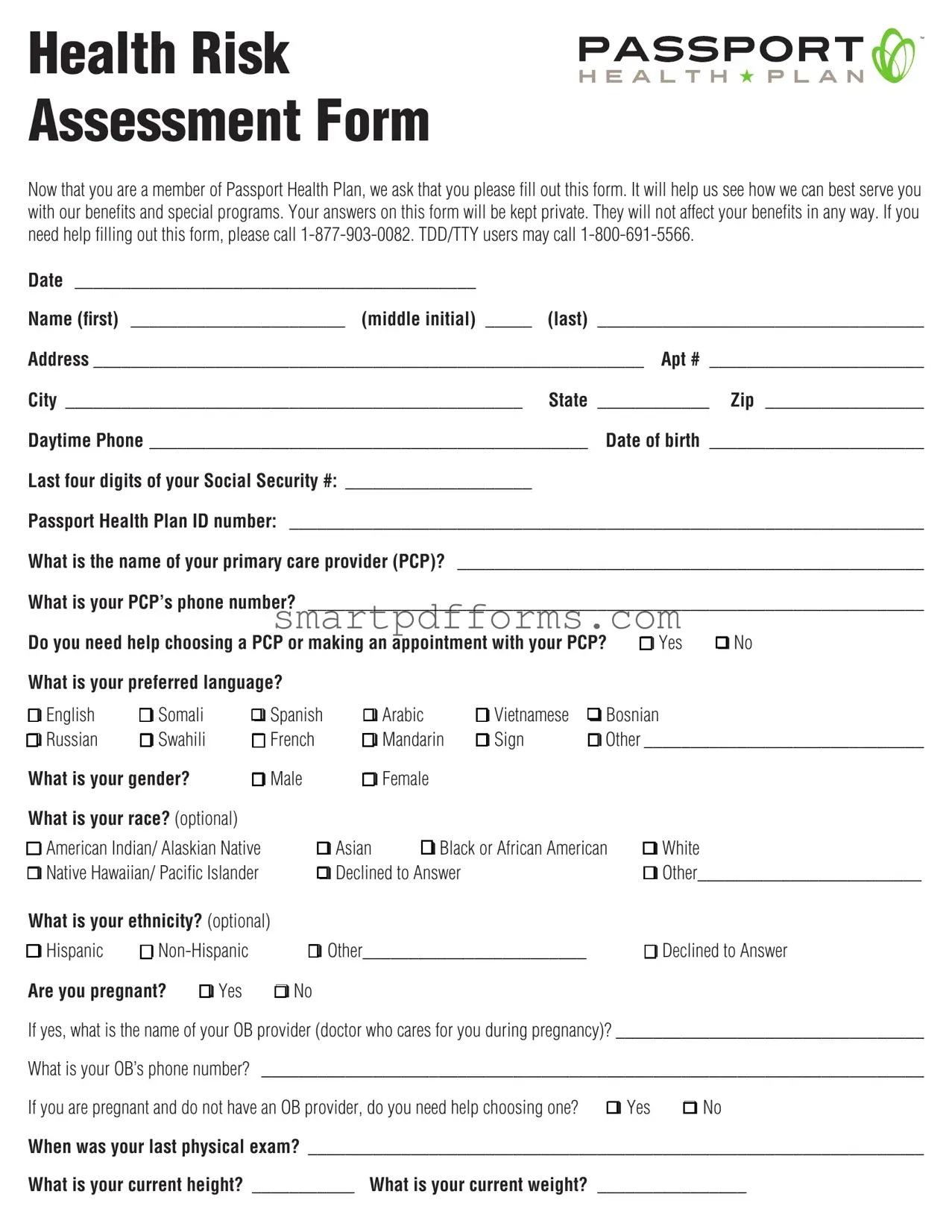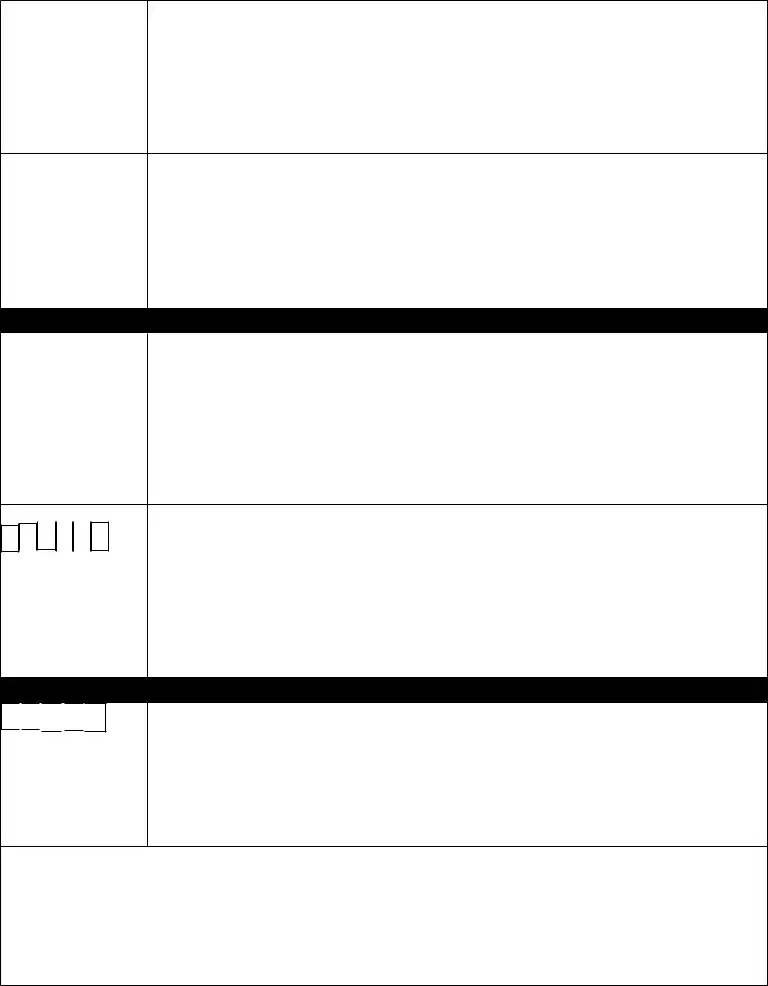|
|
|
|
|
|
|
|
|
|
|
|
|
|
|
|
|
|
1. |
In general, would you say your health is: |
|
|
|
|
|
|
|
|
|
|
|
|
|
|
|
|
|
|
|
|
(circle one number) |
|
|
|
|
1 |
2 |
|
|
3 |
|
|
4 |
|
5 |
|
|
1 - Excellent |
2 - Very Good 3 - Good 4 - Fair 5 - Poor |
|
|
|
|
|
|
|
|
|
|
|
|
|
|
|
|
|
|
The following are activities you might do during a normal day. Please circle one of the numbers to describe |
|
|
|
|
|
|
|
|
|
|
|
|
|
|
|
|
|
|
how much your health limits you in any of these activities. |
|
|
|
|
|
|
|
|
|
|
|
|
|
|
|
|
|
|
|
1 - Yes, limited a lot |
2 - Yes, limited a little |
3 - No, not limited |
|
|
|
|
|
|
|
|
|
|
|
|
|
|
|
|
|
|
|
(circle one number on each line) |
|
|
|
|
|
|
|
|
|
|
|
|
|
|
|
|
|
|
|
2. |
Moderate activities, such as moving a table, pushing a vacuum cleaner, bowling, or playing golf. |
|
|
1 |
2 |
|
|
|
3 |
|
|
|
|
|
|
|
|
|
|
|
|
|
|
|
|
|
|
|
|
|
|
|
|
|
|
|
|
|
|
|
|
1 |
2 |
|
|
|
3 |
|
|
|
|
|
|
|
|
3. |
Climbing several flights of stairs. |
|
|
|
|
|
|
|
|
|
|
|
|
|
|
|
|
|
|
|
During the past 4 weeks, have you had any of the following problems with your work or daily activities as a |
|
|
|
|
|
|
|
|
|
|
|
|
|
|
|
|
|
|
result of your physical health? |
|
|
|
|
q Yes |
q No |
|
|
|
4. |
Could not get done as much as I would like. |
|
|
|
|
q Yes |
q No |
|
|
|
5. |
Was limited in the kind of work or other activities. |
|
|
|
|
|
|
|
|
|
|
|
|
|
|
|
|
|
|
|
|
|
|
|
|
|
|
|
|
|
|
|
|
|
|
|
|
|
During the past 4 weeks, have you had any of the following problems with your work or daily activities as a |
|
|
|
|
|
|
|
|
|
|
|
|
|
|
|
|
|
|
result of any emotional problems (such as feeling depressed or anxious)? |
|
|
|
q Yes |
q No |
|
|
|
6. |
Could not get done as much as I would like. |
|
|
|
|
q Yes |
q No |
|
|
|
7. |
Did not do work or other activities as carefully as usual. |
|
|
|
|
|
|
|
|
|
|
|
|
|
|
|
|
|
|
|
|
|
|
|
|
|
|
|
|
|
|
|
|
|
|
|
|
|
8. During the past 4 weeks, how much did pain get in the way of your normal work (including both work |
|
|
|
|
|
|
|
|
|
|
|
|
|
|
|
|
|
|
|
outside the home and housework)? |
|
|
|
1 |
2 |
|
|
3 |
|
4 |
|
5 |
|
|
1 - Not at all |
2 - Slightly 3 - Moderately |
4 - Quite a bit 5 - Extremely |
|
|
|
|
|
|
|
|
|
|
|
|
|
|
|
|
|
|
|
(circle one number) |
|
|
|
|
|
|
|
|
|
|
|
|
|
|
|
|
|
|
|
|
|
|
|
|
|
|
|
|
|
|
|
|
|
|
|
|
|
|
|
|
|
|
|
|
|
|
|
|
|
|
|
|
|
|
|
|
|
|
|
|
These questions are about how you feel and how things have been with you during the past 4 weeks. For |
|
|
|
|
|
|
|
|
|
|
|
|
|
|
|
|
|
|
each question, please give the one answer that comes closest to the way you have been feeling. |
|
|
|
|
|
|
|
|
|
|
|
|
|
|
|
|
|
|
|
1 - All of the time |
2 - Most of the time 3 - A good bit of the time |
|
|
|
|
|
|
|
|
|
|
|
|
|
|
|
|
|
|
|
4 - Some |
5 - A little of the time 6 - None of the time |
|
|
|
|
|
|
|
|
|
|
|
|
|
|
|
|
|
|
During the past 4 weeks, how often: (circle one number on each line) |
|
|
|
|
|
|
|
|
|
|
|
|
|
|
|
|
|
|
9. |
Have you felt calm and peaceful? |
|
|
1 |
2 |
3 |
|
|
4 |
|
|
|
5 |
|
6 |
|
|
|
|
|
|
|
|
|
|
|
|
|
|
|
|
|
|
|
|
|
|
|
|
|
|
|
|
|
|
|
|
10. |
Did you have a lot of energy? |
|
|
|
1 |
2 |
3 |
|
|
4 |
|
|
|
5 |
|
6 |
|
|
|
|
|
|
|
|
|
|
|
|
|
|
|
|
|
|
|
|
|
|
|
|
|
|
|
|
|
|
|
|
|
11. |
Have you felt sad or down? |
|
|
|
|
1 |
2 |
3 |
|
|
4 |
|
|
|
|
5 |
|
6 |
|
|
|
|
|
|
|
|
|
|
|
|
|
|
|
|
|
|
|
|
|
|
|
|
|
|
|
|
|
|
|
|
|
|
|
|
|
|
|
|
|
|
|
|
|
|
|
|
|
|
|
|
|
|
|
|
|
12. |
During the past 4 weeks, how often has your physical health or emotional problems gotten in the way of |
|
1 |
2 |
3 |
|
|
4 |
|
|
5 |
|
6 |
|
|
your social activities (such as visiting with friends, relatives, etc.)? |
|
|
|
q Yes |
q No |
|
|
|
13. |
Have you seen a psychiatrist or any other mental/emotional health provider previously? |
|
|
|
|
|
|
|
|
|
|
|
|
|
|
|
|
|
|
|
|
|
|
|
|
q Yes |
q No |
|
|
|
14. |
Have you ever been in a psychiatric facility? |
|
|
|
|
|
|
|
|
|
|
|
|
|
|
|
|
|
|
|
|
|
|
|
|
|
q Yes |
q No |
|
|
|
15. |
Are you on any behavioral health medicines? |
|
|
|
|
|
|
|
|
|
|
|
|
|
|
|
|
|
|
|
|
If yes, what are they? _____________________________________ |
|
|
|
|
|
|
|
|
|
|
|
|
|
|
|
|
|
|
|
|
|
|
|
q Yes |
q No |
|
|
|
16. |
Have you ever been treated for substance abuse (alcohol, drugs)? |
|
|
|
|
|
|
|
|
|
|
|
|
|
|
|
|
|
|
|
|
|
|
|
q Yes |
q No |
|
|
|
17. |
Do you need help getting a counselor, therapist, or psychiatrist? |
|
|
|
|
|
|
|
|
|
|
|
|
|
|
|
|
|
|
|
|
|
|
|
q Yes |
q No |
|
|
|
18. |
Do you need help getting food, clothing or housing? |
|
|
|
|
|
|
|
|
|
|
|
|
|
|
|
|
|
|
|
|
|
|
|






 2
2 
 3
3 
 4
4 
 5
5